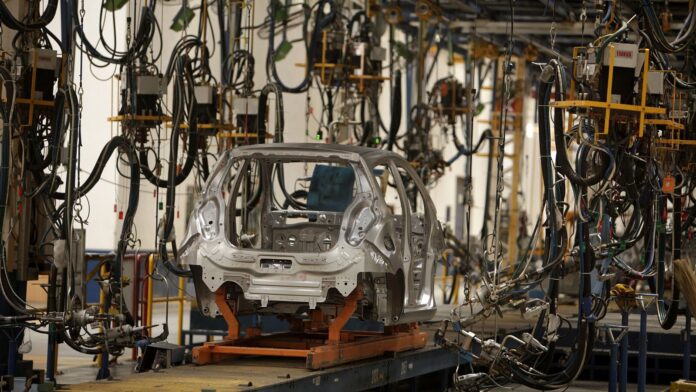Large Indian component makers are collaborating with automakers closer than ever before, jointly ideating complex steering, chassis and braking systems, before building and delivering them. The shift to so-called Tier 0.5 manufacturing marks a shift in their traditional role of making individual parts as ordered, as vehicle systems become increasingly complex and diverse.
Component suppliers are typically classified based on their closeness to the automaker. Tier 1s deliver full systems or modules based on automaker specifications, while Tier 2s supply smaller parts to Tier 1s. The emerging Tier 0.5 suppliers go a step further, integrating themselves into the development and design phase itself.
“The Tier 0.5 concept marks a fundamental shift from the conventional ‘build-to-print’ role of suppliers to that of co-creators and system integrators,” said Arvind Goel, vice-chairman at Tata AutoComp Systems Ltd, which makes cockpit modules, seating and console systems. “Unlike Tier 1s that join the programme after specification freeze, Tier 0.5 partners participate from the early concept stage, taking shared responsibility for system performance, lifecycle cost and digital enablement.”
The shift to Tier 0.5 marks yet another step in the evolution of India’s auto component industry. Mint reported on 3 October how many such companies such as Sona Comstar, Anand Group and Minda Corp. are expanding abroad, following a playbook perfected by the Samvardhana Motherson Group. By taking control of complete systems and assemblies, these companies are joining a niche group of elite Tier 0.5 suppliers such as Motherson, Bosch and ZF.
Driving the change is the auto industry’s pivot toward multiple powertrain technologies and greater software integration. Automakers are grappling with the development of electric vehicles (EVs), hybrids and compressed natural gas (CNG) systems, coupled with the increasing role of software-defined vehicles (SDVs). This complexity prompts original equipment manufacturers (OEMs) to rely on suppliers who can manage and integrate entire vehicle systems autonomously, freeing up the automakers’ internal research and development teams to concentrate on core next-generation technologies.
“With automakers focusing on so many technologies such as EVs, hybrids, CNG and the increasing role of SDV, they want to work with suppliers who can handle entire systems as they want to focus their efforts elsewhere,” a consultant for component firms said on the condition of anonymity. “Every big component maker will move or is already moving in this direction to become a Tier 0.5 supplier.”
Executives at Lumax Auto Technologies and Belrise Industries confirmed they are pursuing similar integration strategies.
Belrise Industries Ltd, which makes chassis, exhaust and suspension systems, is shifting from merely supplying basic chassis components to delivering the entire chassis assembly for a major Japanese two-wheeler maker, chief marketing officer Sunil Kulkarni said, taking over a function previously handled internally by the manufacturer. “Similarly, for a commercial vehicle OEM, we shifted from a multi-vendor setup to becoming their single-source supplier for complete chassis systems, reinforcing long-term trust and operational efficiency,” Kulkarni said, noting the effort was driven by investment in supply-chain automation and digital integration starting 15 years ago.
“This transformation has been driven by significant investment in supply-chain automation and digital integration. Our systems interface seamlessly with numerous suppliers across diverse models, ensuring traceability at every stage,” Kulkarni added.
Lumax Auto Technologies, a maker of lighting systems and seat structures, is prioritizing its evolution into a Tier 0.5 system integrator as a central part of its mid-term strategy. “We are moving beyond component manufacturing to deliver complete, modular systems that combine hardware, software and design into integrated solutions,” said managing director Anmol Jain. Jain noted the shift is enabled through focused technology investments, including a forthcoming software and innovation hub in Bengaluru and a new resource centre in China, which strengthen the company’s ability to co-create with OEMs from the design stage.
The transition requires significant investment in both hardware and software capabilities.
Tata AutoComp has introduced a phased approach, focusing on reinforcing its in-house engineering capabilities to enable the transition from component manufacturing to system-level design and integration. “The next phase of the Tata Autocomp journey will deepen co-creation and digital integration with OEMs,” Goel said.
Moving up the value chain is critical for the sector, which is facing the heat of US tariffs on Indian exports. According to an Icra Ltd report, these tariffs are expected to affect around 8% of India’s overall auto component output. The disruption will put Indian auto component exporters at a relative disadvantage compared to most of their Asian peers, Icra said, highlighting the urgency of concluding an India-US bilateral trade agreement.
tier 0.5 supplier india,indian auto component industry,auto component makers shift,automotive system integrators,oem-supplier collaboration india,software defined vehicles india,ev component manufacturing india,indian auto r&d investment,co-creation auto suppliers,system performance responsibility,tata autocomp tier 0.5,lumax auto technologies strategy,belrise industries chassis,india auto component exports,us tariffs indian auto parts,component manufacturing evolution,automaker core technology focus,steering chassis braking systems,auto supply chain diversification,hardware software integration automotive
#quiet #gear #shift #Indias #auto #part #makers

